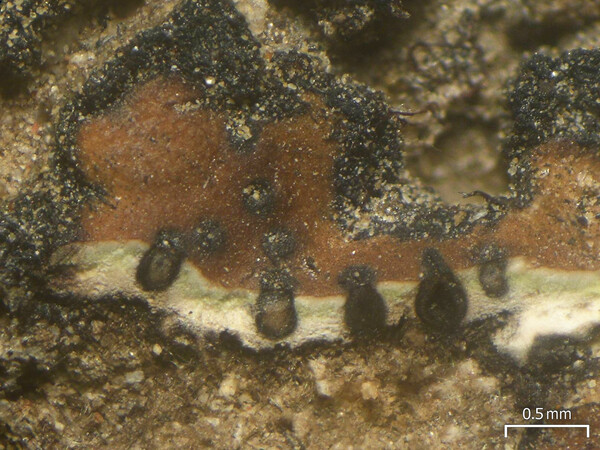Placidium michelii A. Massal.
Sched. Crit., 5: 100, 1856.
Synonyms: Catapyrenium michelii (A. Massal.) R. Sant.; Dermatocarpon michelii (A. Massal.) Zwackh; Endocarpon michelii (A. Massal.) Bausch; Endopyrenium michelii (A. Massal.) Körb.
Description: Thallus squamulose, the squamules closely adpressed to the substratum, 1-5 mm wide, up to 0.25 µm thick, rounded to undulate, flattened, smooth, scattered to contiguous. Upper surface pale to dark chestnut brown, matt; lower surface black, attached by a dense mat of 4-6 µm thick, colourless rhizohyphae. Upper cortex paraplectenchymatous, 20-65 µm thick, without or with a very thin epinecral layer; medulla of globular cells intermixed with a few elongated cells; lower cortex thin, poorly differentiated, consisting of 1-3 layers of cells, the lower ones pigmented. Perithecia laminal, pyriform, immersed in the squamules, up to 0.35 mm across, without involucrellum. Exciple rather thin (to 25 µm), initially colourless, but soon turning dark brown throughout, starting from the ostiole; paraphyses absent, periphyses measuring 30-40 x c. 2.5 μm. Asci 8-spored, cylindrical, thin-walled, non-amyloid and without an ocular chamber, with uniseriately arranged spores, 60-70 x 10-12 μm. Ascospores 1-celled, hyaline, ellipsoid, thin-walled, 11-15 x 5-6 µm. Pycnidia rare, multilocular, Dermatocarpon-type, laminal, immersed, black. Conidia oblong-ellipsoid, 2.5-3.5(-4) x 1.2-1.5 µm. Photobiont chlorococcoid. Spot tests: cortex and medulla K-, C-, KC-, P-, UV-. Chemistry: without lichen substances.
Growth form: Squamulose
Substrata: soil, terricolous mosses, and plant debris
Photobiont: green algae other than Trentepohlia
Reproductive strategy: mainly sexual
Commonnes-rarity: (info)
Alpine belt: absent
Subalpine belt: absent
Montane belt: rare
Dry submediterranean belt: very rare
Humid submediterranean belt: absent
Padanian area: absent
pH of the substrata:
1 2 3 4 5
Solar irradiation:
1 2 3 4 5
Aridity:
1 2 3 4 5
Eutrophication:
1 2 3 4 5
Poleotolerance:
0 1 2 3
Altitudinal distribution:
1 2 3 4 5 6
Rarity
absent
extremely rare
very rare
rare
rather rare
rather common
common
very common
extremely common
Loading data...
Occurrence data
Predictive map
Growth form: Squamulose
Substrata: soil, terricolous mosses, and plant debris
Photobiont: green algae other than Trentepohlia
Reproductive strategy: mainly sexual
Commonnes-rarity: (info)
Alpine belt: absent
Subalpine belt: absent
Montane belt: rare
Dry submediterranean belt: very rare
Humid submediterranean belt: absent
Padanian area: absent
pH of the substrata:
| 1 | 2 | 3 | 4 | 5 |
Solar irradiation:
| 1 | 2 | 3 | 4 | 5 |
Aridity:
| 1 | 2 | 3 | 4 | 5 |
Eutrophication:
| 1 | 2 | 3 | 4 | 5 |
Poleotolerance:
| 0 | 1 | 2 | 3 |
Altitudinal distribution:
| 1 | 2 | 3 | 4 | 5 | 6 |
Rarity
absent
extremely rare
very rare
rare
rather rare
rather common
common
very common
extremely common
Loading data...
Occurrence data
Predictive map







